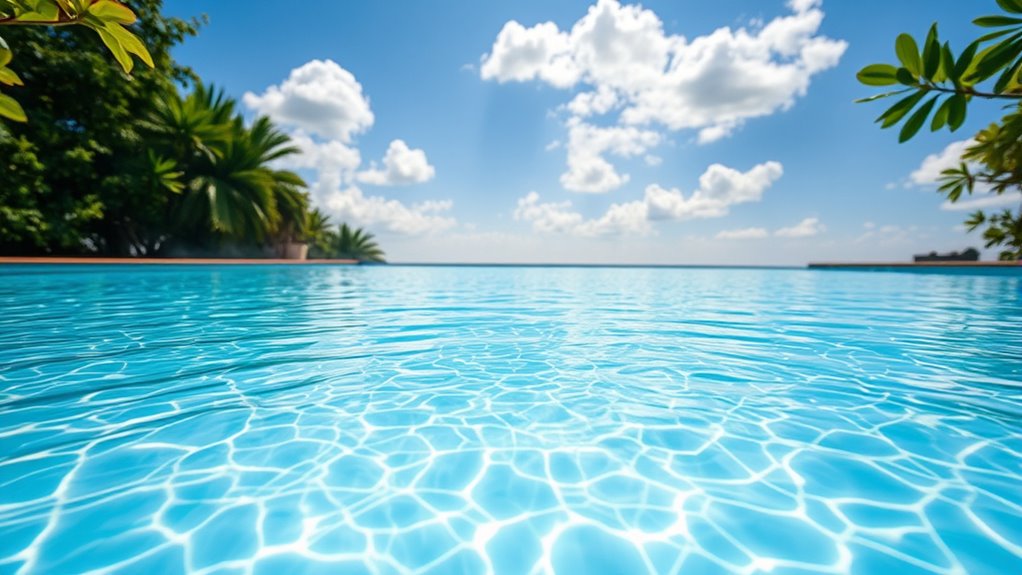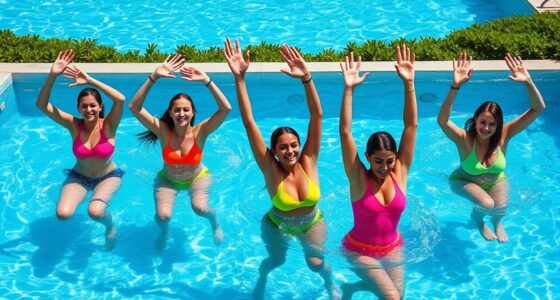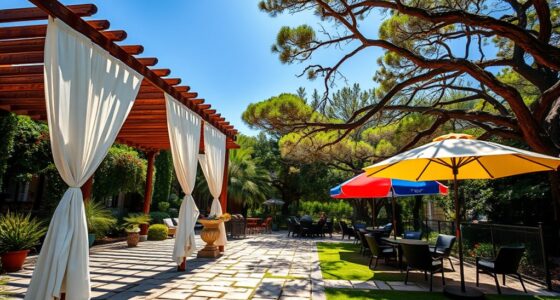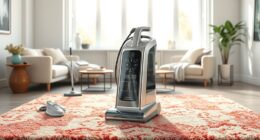For the perfect pool temperature that guarantees your comfort, aim for between 78°F and 82°F. At 82°F, you’ll find it ideal for relaxing and leisure activities, while 78°F helps prevent overheating during active swimming. Adjust within this range based on your preferences and weather conditions to stay comfortable and safe. Maintaining the right temperature enhances your swimming experience—continue here to discover more tips for creating an ideal pool environment.
Key Takeaways
- Maintain water temperature between 78°F and 82°F for optimal comfort and relaxation.
- Adjust temperature based on activity type—lower for active swimming, higher for leisure.
- Regularly monitor and fine-tune the water temperature to match weather changes and user preferences.
- Avoid water that’s too cold or hot to prevent discomfort, fatigue, or health risks.
- Creating a consistent, personalized temperature ensures a pleasant and safe swimming experience.

Finding the perfect pool temperature can make all the difference in your swimming experience. When you focus on pool temperature adjustment, you can create ideal swimming conditions that keep you comfortable and motivated to enjoy the water. The right temperature isn’t just a matter of preference; it influences how long you want to stay in the pool, how well your muscles perform, and how your body responds to the water. By understanding the ideal temperature range, you ensure every swim session feels just right.
Most experts agree that a pool temperature between 78°F and 82°F offers the best balance of comfort and functionality. If your goal is leisure and relaxation, keeping the water closer to 82°F provides a cozy environment that’s warm enough for lounging without feeling stuffy. For more active swimming or lap workouts, slightly cooler water around 78°F helps prevent overheating and keeps you energized. Adjusting the pool temperature within this range allows you to tailor the environment to your specific needs and activities, ensuring you get the most out of each swim.
Maintaining a pool temperature of 78°F to 82°F balances comfort and performance for all swimming activities.
Changing the pool temperature isn’t just about making the water warmer or cooler; it’s about fine-tuning your environment for ideal swimming conditions. If you notice that your muscles feel stiff or your skin feels uncomfortable, it’s time to make a pool temperature adjustment. Many modern pools come equipped with heaters and digital controls, making it easy to set the water to your preferred temperature with a simple tap or dial. Regularly monitoring the water temperature ensures that it remains consistent, especially if weather conditions fluctuate or if the pool is used frequently. Additionally, understanding water quality and flow rate can help optimize your pool’s performance and comfort.
Temperature regulation plays a key role in maintaining a safe and enjoyable swimming environment. Water that’s too cold can cause hypothermia or make you tense up, while water that’s too hot might lead to fatigue or dehydration. Striking the right balance ensures your body stays comfortable and your muscles stay relaxed without overexertion. Whether you’re swimming for exercise, therapy, or leisure, maintaining the proper pool temperature helps you maximize the benefits and minimizes discomfort.
Ultimately, the goal is to find a temperature that feels just right for you. Regularly adjusting and maintaining your pool’s temperature helps you create the perfect setting for every swim, ensuring you always enjoy ideal swimming conditions. Whether you prefer a cozy, warm soak or a brisk, invigorating swim, knowing how to control your pool temperature makes all the difference in elevating your water experience.
Frequently Asked Questions
How Does Altitude Affect Ideal Pool Temperature?
Altitude affects your ideal pool temperature through altitude adjustment and thermal stratification. At higher elevations, the air is thinner, so you might need to raise your pool temperature slightly to stay comfortable. Thermal stratification can also occur, creating temperature layers in the water. To make certain of comfort, consider increasing your pool’s temperature by a degree or two for every 1,000 feet of elevation, balancing warmth and energy efficiency.
Do Pool Temperatures Vary by Geographic Location?
You’ll find that pool temperatures do vary by geographic location due to climate influence. For instance, northern regions often keep pools cooler, around 78-82°F, while tropical areas prefer warmer temps, about 84-88°F. Regional preferences are shaped by local weather, making your ideal pool temperature a personalized choice. Understanding these differences helps you enjoy your swim more, whether you’re cooling off in the heat or relaxing in cooler waters.
How Quickly Can Pool Temperature Be Adjusted?
You can usually adjust pool temperature within a few hours, depending on your heating method. Solar heaters gradually increase temperature with sunlight, causing minor fluctuations, while gas or electric heaters can raise the temperature more quickly, often within 3-4 hours. Keep in mind, rapid temperature fluctuations are uncommon unless you’re actively using a powerful heater. To maintain consistent comfort, plan your heating schedule around your preferred swimming times.
Are There Health Risks Associated With Certain Temperatures?
Yes, there are health risks associated with certain pool temperatures. If your pool is too cold, you risk hypothermia, which can cause chills, fatigue, and even cardiac issues. Conversely, overly warm water can lead to overheating, dehydration, and skin infections. Maintaining proper pool safety involves keeping the water at a temperature that balances thermal comfort and reduces these risks, typically around 78-82°F for most swimmers.
What’s the Best Way to Measure Pool Temperature Accurately?
To measure your pool temperature accurately, you should use a reliable thermometer placed properly. Position a digital or analog thermometer at the water’s edge or submerged where the water flow is steady, avoiding direct sunlight or near the filter inlet. Digital thermometers offer quick readings and easy calibration, while analog ones are simple and durable. Regularly check and calibrate your thermometer to guarantee precise temperature readings.
Conclusion
So, now that you know the perfect pool temps, go ahead—brave the icy depths or lounge in the warm embrace of paradise. Just remember, no matter how much you pretend to enjoy the freezing splash or the sauna-like heat, your true comfort lies somewhere in between. So, pick your poison, splash around, and pretend you’re a professional swimmer or a luxurious lounge lizard—because who really knows what’s best, right?










